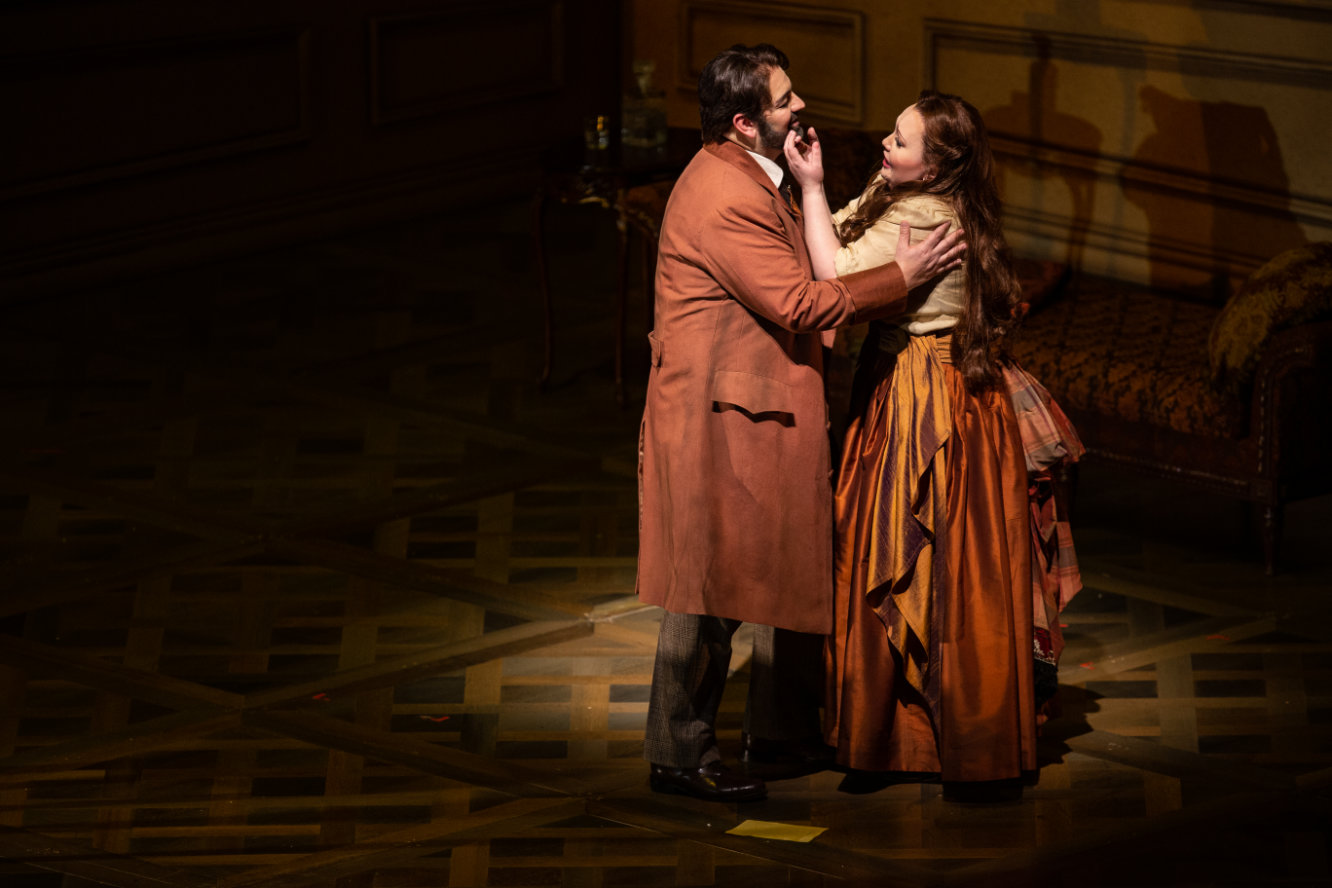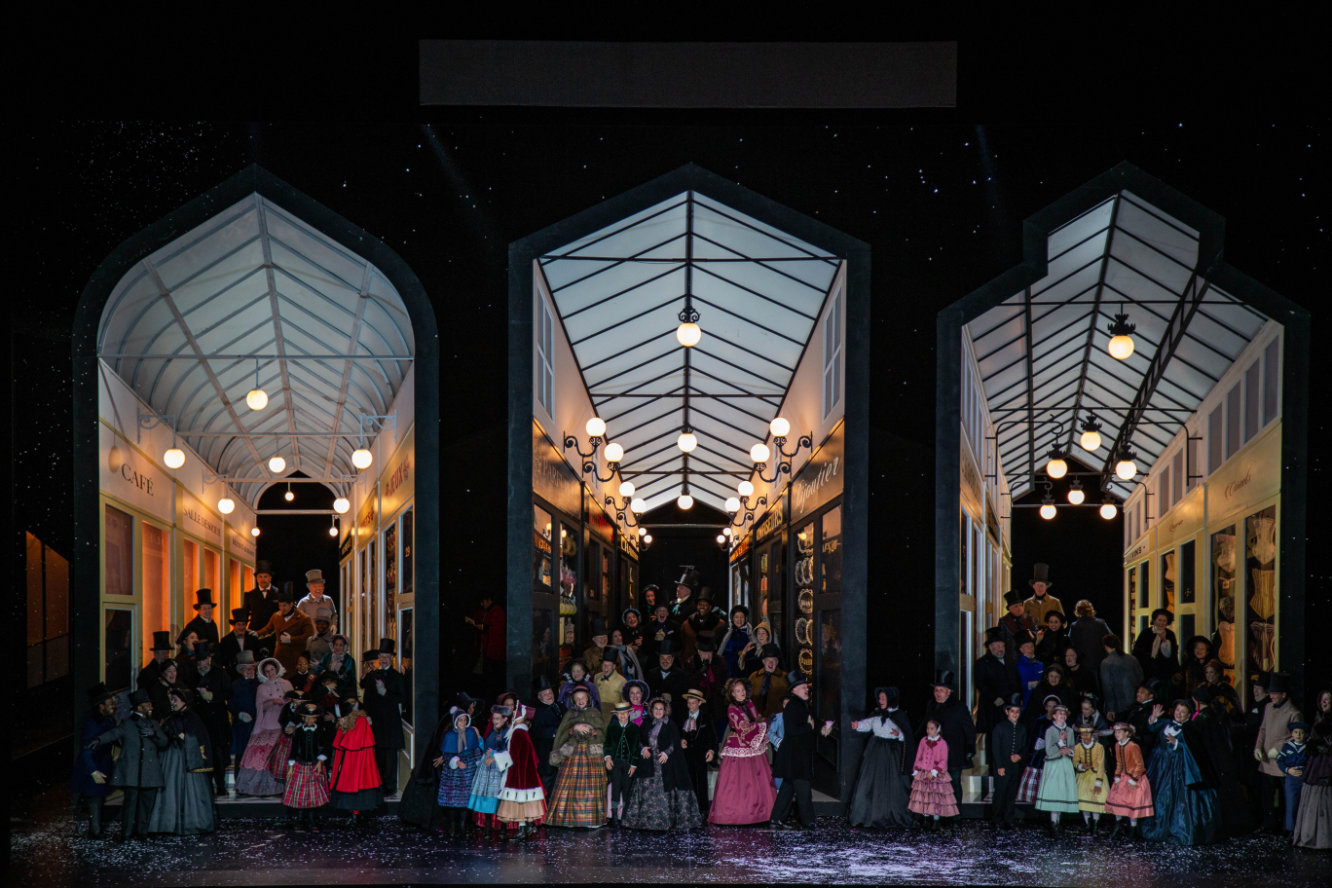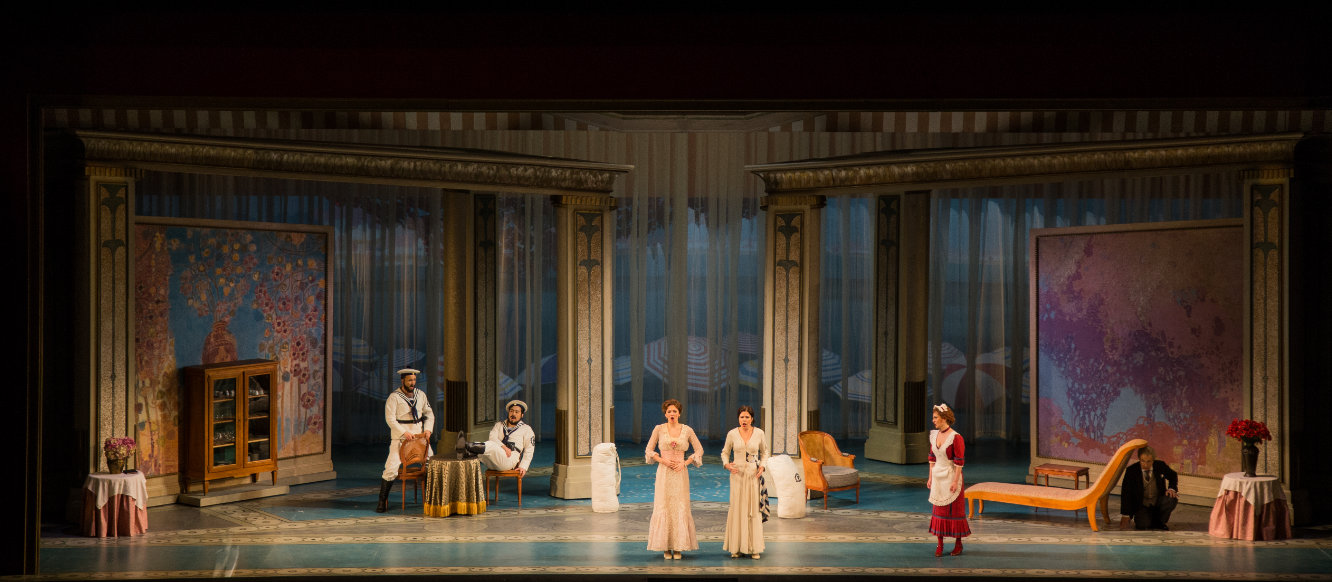The opening of Lyric Opera of Chicago’s Die Walküre was a thrilling spectacle to behold. Operagoers who were fortunate enough to experience the five-hour event were spellbound by a stunning set, gorgeous orchestral colors, and exquisite vocal performances.

Elisabet Strid as Sieglinde.
Photo credit: Cory Weaver
This production exposes the magic behind the theatrics. It takes place in a theater where the audience can clearly see the stagehands roll set pieces around and act as puppeteers, manipulating the movements of horses carrying Brünnhilde and her Valkyrie sisters. The production opens with the setting of the stage – literally. As the storm rages in the orchestra, Wotan directs the placement of set pieces, instructing the great ash to descend from above into Hunding’s home. Two chairs adorned with the horns of the cuckold are placed on opposing ends of the rustic table, and we see a distraught Sieglinde chained to the ash tree, making Sieglinde’s plight abundantly clear.
The sexual side of the relationship between the sibling lovers Siegmund and Sieglinde, played by tenor Brandon Jovanovich and soprano Elisabet Strid, respectively, was emphasized more than I’ve seen in other productions: as Siegmund drew the sword from the ash in Hunding’s home, Sieglinde lay on her back, arms stretched out above her head, hips in the air. The first act ended with the lovers in a grassy patch, consummating their love. This was not a production with mere handholding and lovely glances.
I was also surprised to see a set change in Act I, which takes place exclusively in Hunding’s home. At the mention of “spring,” the scene behind Siegmund and Sieglinde transformed completely, as did the orchestral colors. The characters found themselves in lush green vegetation, changing the entire mood of the production. It was an effective choice that served the production well.

Brandon Jovanovich as Siegmund and Elisabet Strid as Sieglinde.
Photo credit: Cory Weaver
Act II opened with a surprise: Siegmund and Sieglinde, clearly spent after their romp in the grassy patch during the first 30 minute intermission, were still there, embracing one another. Sieglinde, suddenly overcome by embarrassment, jumps up and is covered by Siegmund. She runs off stage, with Siegmund quickly following her, thus effectively establishing the lighter, comic mood that was to dominate the opening of Act II.

Eric Owens, playing Wotan, and Tanja Ariane Baumgartner, playing Fricka.
Photo credit: Cory Weaver

Christine Goerke as Brünnhilde, Brandon Jovanovich as Siegmund, and Elisabet Strid as Sieglinde.
Photo credit: Cory Weaver
A tuxedo-wearing Wotan, played by the phenomenal bass-baritone Eric Owens, descends from above as the balcony of his great fortress Valhalla falls into place. His tomboy Valkyrie daughter, Brünnhilde, played by soprano Christine Goerke, remains below, on an equal footing with the human characters of the first act. As Fricka, Wotan’s wife, played by mezzo Tanja Ariane Baumgartner, arrives in her chariot adorned with the skull of a ram, I hear the audience giggle – a reaction heard quite frequently in this first part of Act II.
Another interesting choice occurred later in Act II: when Brünnhilde arrives on her horse controlled by stagehands and speaks with Siegmund to inform him that he will perish in the duel with Hunding, played by bass Ain Anger, the two characters don’t speak face-to-face. Instead, both face the audience with Brünnhilde upstage. I was reminded of Greek mythology: there are countless tales in which gods and goddesses reveal themselves to mortals in dreams and dreamlike states as opposed to face-to-face interactions. Was it all happening inside Siegmund’s mind?

Hunding, played by Ain Anger, fights Siegmund, played by Brandon Jovanovich.
Photo credit: Cory Weaver
The duel between Siegmund and Hunding was beautifully staged. The opposing forces and their supporting gods and goddesses were on opposite sides of the stage. Hunding and Siegmund stood atop raised set pieces quite far from one another; there was no need to bring in a stage fighting coach for this one. Fricka, the protectress of the bonds of marriage, stood on the scaffolding behind Hunding, while Wotan, forced to accept the death of his child, Siegmund, nonetheless stood behind his son, clearly revealing his true desire – the one that his daughter, Brünnhilde, attempts to uphold.

The Valkyries
Photo credit: Cory Weaver
Act III’s opening with the famous Ride of the Valkyries was visually stunning: three Valkyrie daughters weaved through the air on horses as the others attached the corpses of fallen heroes to Valhalla. One hero who hadn’t quite yet succumbed had his neck snapped ruthlessly by one of the Valkyries. There was no shortage of blood and gore.
The opera concludes beautifully with the tender embrace of Wotan and Brünnhilde, right before War-Father kisses his favorite daughter into slumber and summons Lӧge to surround the sleeping Brünnhilde with a ring of fire in order to protect her from unfit mortal men.
Vocal performances were top notch throughout the production. The orchestra, led by Sir Andrew Davis, who is celebrating his 30th year at Lyric, was as powerful and nuanced as ever. I delighted in the astounding array of colors and moods captured by the orchestra. There were a few entrances that could have been tighter, as well as some intonation and minor balance issues, but overall it was a superb orchestral performance.
As I think back on opening night, there are three things that really stand out in my mind: the staging, the orchestral colors, and the vocal performances. These elements contributed to an exhilarating opening that was both true to the story and accessible to 21st century audiences.



1 Comment
Eric Owens on Wotan, other roles, and his love of opera · November 19, 2017 at 11:58 am
[…] In Review: Lyric Opera of Chicago’s Die Walküre, 2017 – “A stunning set, gorgeous… […]
Comments are closed.